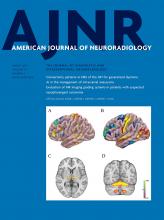With interest, we read the article by Bhatia et al1 about a retrospective study of 8 patients with genetically confirmed mitochondrial encephalopathy with lactic acidosis and stroke-like episodes (MELAS). It was found that among 31 imaging studies, performed between 2006 and 2018, forty-one lesions were “new” in 17 studies.1 It was concluded that cortical lesions most commonly affect the primary visual, the primary somatosensory, and the primary auditory cortices.1 The study has a number of limitations and shortcomings.
Because patients with MELAS may develop involvement of the heart,2 we should know how many of these 8 patients had cardiac disease, in particular atrial fibrillation, atrial flutter, ventricular arrhythmias, cardiomyopathy, noncompaction, or heart failure. Acute cortical lesions may be due to cardiac disease, so it is crucial to know the results of cardiac investigations. We also should know the current medication.
A further shortcoming of the study is that only 15 of the 31 studies had an acute indication. The other 16 studies were follow-ups (n = 15) or screening (n = 1).1 In contrast, 41 T2-hyperintense lesions were found in the acute stage according to Table 2, suggesting that the 16 studies without an acute indication were also included in this evaluation. This discrepancy requires clarification.
Furthermore, it is unclear whether patients with “new” lesions progressed clinically between 2 consecutive MR imaging investigations. We also should know the intervals between the previous and current MR imaging that were used for classifying a lesion as new.
Because the phenotype of MELAS and thus the phenotypic variability among the 8 patients strongly depend on the heteroplasmy rate of the m.3243A>G variant, it is crucial to know the amount of mutated mitochondrial DNA in the mitochondria in the 8 included patients. A heteroplasmy rate of only 21% in patient 2 raises doubts about the causality of the mutation.
The morphologic correlate of a stroke-like episode (SLE) is the stroke-like lesion (SLL) on imaging, best visualized on MR imaging.3 Because patients 1, 4, and 8 experienced SLEs, we should know whether these 3 patients also showed SLLs on MR imaging and the appearance of these SLLs. SLLs typically present with hyperintensity on DWI, ADC, and PWI, but hypointensity on oxygen extraction fraction MR imaging.3 Occasionally, however, this pattern is variable, and there are SLLs that show a mixture of vasogenic and cytotoxic edema or solely cytotoxic edema in a nonvascular distribution of the lesion.
Because MELAS is characterized by lactic acidosis in the serum and the CSF,4 we should know the serum and CSF lactate values (determined by CSF investigation or MR spectroscopy) in the 8 included patients. Lactate levels may correlate with the severity of the MELAS phenotype.
In Table 2, the authors differentiate between “ADC prior low” and “ADC prior normal/high.”1 However, in none of the cases is the ADC during the first week described as normal/high.1 Only low ADC values are mentioned. This discrepancy requires clarification.
A further discrepancy concerns the SWI sequences. In the acute stage (first week), low SWI was described in none of the investigations. However, in the subacute stage (weeks 4–8), 7 investigations with low SWI were described among those with ADC prior low.1 We should know whether low SWI was interpreted as bleeding, and bleeding occurring 4–8 weeks after onset should be explained.
We should also know whether the classifications “acute,” “subacute,” and “chronic” refer to the clinical presentation or the MR imaging findings. If these categories refer to the MR imaging findings, we should know whether changes on MR imaging were accompanied by a clinical correlate.
Not only the metabolic and angiopathic hypotheses have been proposed to explain the development of an SLL but also the epileptogenic hypothesis.
Overall, this interesting study has a number of shortcomings as outlined above, which need to be addressed before final conclusions can be drawn. SLEs in m.3243A>G carriers need to be prospectively monitored by MR imaging starting with the onset of clinical manifestations.
- © 2020 by American Journal of Neuroradiology












